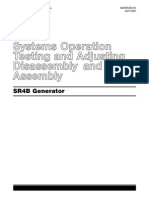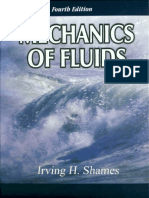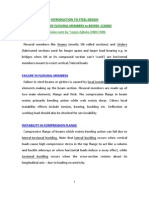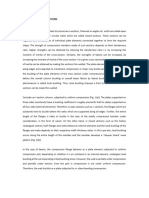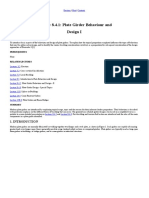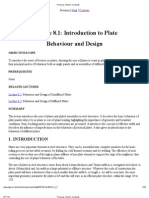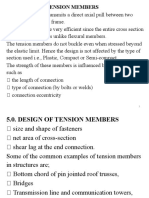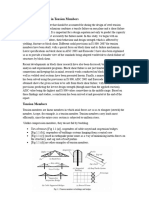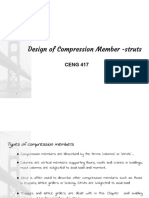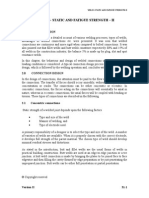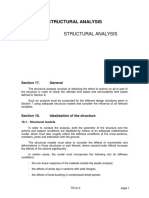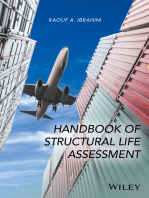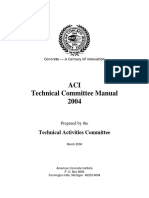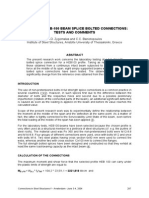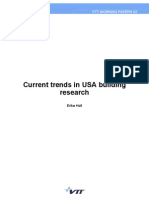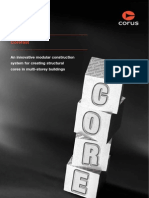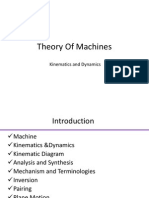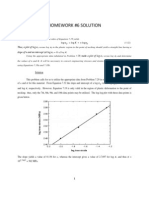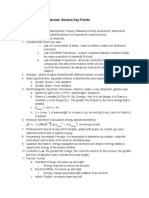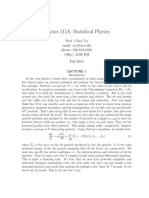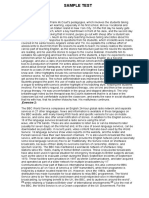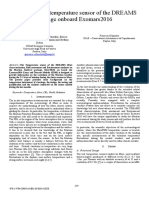Lecture 9.3 Design Procedures For Beams: Objective/Scope
Lecture 9.3 Design Procedures For Beams: Objective/Scope
Uploaded by
S.s. LeeCopyright:
Available Formats
Lecture 9.3 Design Procedures For Beams: Objective/Scope
Lecture 9.3 Design Procedures For Beams: Objective/Scope
Uploaded by
S.s. LeeOriginal Description:
Original Title
Copyright
Available Formats
Share this document
Did you find this document useful?
Is this content inappropriate?
Copyright:
Available Formats
Lecture 9.3 Design Procedures For Beams: Objective/Scope
Lecture 9.3 Design Procedures For Beams: Objective/Scope
Uploaded by
S.s. LeeCopyright:
Available Formats
Previous | Next | Contents
1 18
Previous | Next | Contents
ESDEP WG 9
THIN-WALLED CONSTRUCTION
Lecture 9.3 Design Procedures for Beams
OBJECTIVE/SCOPE
To present design methods for thin-walled flexural members.
PREREQUISITES:
Lecture 6.1: Concepts of Stable and Unstable Elastic Equilibrium
Lecture 7.3: Local Buckling
Lecture 9.1: Thin-walled Members and Sheeting
Lecture 9.2: Design Procedures for Columns
RELATED LECTURES:
Lecture 6.2: General Criteria for Elastic Stability
SUMMARY:
Design methods for thin-walled flexural members are presented which take into account the different kinds of
buckling acting in such members and also shear lag. In particular the design of purlins is discussed.
1. INTRODUCTION
Thin-walled flexural members are applied for carrying lateral loads such as gravity loads in roofs for example.
Their behaviour can be affected by local buckling, shear lag, web crippling, flange curling and lateral buckling.
The effect of local buckling is covered in design by effective widths of the cross-section based on the stress
distribution produced by bending moments and axial force.
For shear lag, web crippling and flange curling design rules are given in Eurocode 3, Part 1.3 [1].
Lateral-torsional buckling has to be evaluated similarly to hot-rolled sections taking the effective cross-section
values into account.
Thin-walled cold-formed flexural members have their most important application in wall and roof constructions
as purlins. The structural connection with the sheeting provides purlins with lateral and torsional restraints at
one flange. This connection gives the purlin high additional stiffness compared to that of a free purlin spanning
from frame to frame. The values of torsional restraints have to be measured by testing.
2. PREPARATION OF DESIGN PROCEDURES
2.1 Resistance Moment MRd
The resistance moment MRd is the ultimate bending moment of a cross-section with pure bending.
2.1.1 Plastic resistance moment
If flexural members are not subjected to twisting or lateral-torsional buckling the resistance moment MRd may
be found utilizing plastic reserves. By iterative calculations the resistance moment MRd can be determined under
the following conditions:
l
At the compression side the effective widths due to the given compressive stress distribution in the iteration
step are used. Under particular conditions the compression strain may reach a maximum strain higher than
fy/E. Otherwise the compression edge may only reach yield stress fy.
At the tension side the full cross-section can be utilised. Plastic strain may occur. The tension strains are
not limited.
Figure 1 shows an example: Plastic strains occur at the tension side beyond the elastic limit until the
compression stresses just reach yield stress, too.
http://www.haiyangshiyou.com/esdep/master/wg09/l0300.htm
2014-01-28
Previous | Next | Contents
2 18
2.1.2 MRd with respect to buckling
The resistance moment MRd which takes lateral or torsional buckling into account is calculated with the value kd
from the European buckling curves (parameter a). This value is a reduction factor for determination of MRd from
the plastic resistance moment fy . Weff due to the slenderness of the member. The formulae are given below:
2
LT
fLT = 0,5 . [1 + ad . ( LT - 0,2) +
cLT =
2
]
LT
but 1,0
MRd = cLT . fy . Weff
2.2 Shear Lag
In wide flanges (b L/20) the normal stress distribution due to axial force and bending moment can be affected
by shear deformations (see Figure 2). Shear lag appears at locations with large shear stresses, for example at
supports. The effective area is calculated similarly to the effective widths due to local buckling by multiplying the
gross area with a reduction factor ys. The final effective widths which take into account local bucking and shear
lag are given by:
bef = ys . r . bp
http://www.haiyangshiyou.com/esdep/master/wg09/l0300.htm
2014-01-28
Previous | Next | Contents
3 18
Singly supported elements have a further reduction of 15%. The reduction factor ys may be taken from Figure 3
as an approximation.
http://www.haiyangshiyou.com/esdep/master/wg09/l0300.htm
2014-01-28
Previous | Next | Contents
4 18
2.3 Flange Curling
Cross-sections with wide flanges or arched profiles subjected to flexure may show an effect which is called
"flange curling": The membrane stresses due to the bending moment have to be turned around the curvature of
the element or of the deformation which causes lateral loads. Hence the wide flange is bent additionally as
shown in Figure 4 and consequently the cross-section stiffness and modulus W decreases. The amplitude of this
deformation may be estimated using formulae in Eurocode 3 [1]. The cross-section properties are calculated
now on the basis of the cross-section with curved geometry due to flange curling.
http://www.haiyangshiyou.com/esdep/master/wg09/l0300.htm
2014-01-28
Previous | Next | Contents
5 18
Flange curling is a second order effect. In many cases, however, cross-section deformations similar to flange
curling occur already due to first order theory. This cross-section distortion may become much bigger than
flange curling and should be taken into account using an appropriate theory. For example cassettes without
lateral supports at the free flanges show this behaviour.
2.4 Lateral and Torsional Restraints
Lateral and torsional restraints may be given to the beam by the adjacent construction. These restraints are
found mostly when dealing with purlins which are directly connected to the sheeting of the roof. Figure 5 shows
an example.
http://www.haiyangshiyou.com/esdep/master/wg09/l0300.htm
2014-01-28
Previous | Next | Contents
6 18
For the design of the beam these restraints may be idealised as a rigid lateral support and a torsional restraint
cn at the flange which is connected to the sheeting (Figure 6).
http://www.haiyangshiyou.com/esdep/master/wg09/l0300.htm
2014-01-28
Previous | Next | Contents
7 18
The stiffness cn has to be determined partly by testing, partly by calculation. cn is a serial combination of the
stiffness of sheeting and the local connection. The stiffness of the local connection can be determined with the
test setup in Figure 7. Since the deformation d involves the web bending, the flange deflection has to be reduced
by the cross-section deformation.
http://www.haiyangshiyou.com/esdep/master/wg09/l0300.htm
2014-01-28
Previous | Next | Contents
8 18
3. DESIGN OF BEAMS
3.1 Design of Beams without Lateral-Torsional Buckling
Beams may be stressed by axial force and bending moments. If local buckling has to be considered, effective
widths have to be introduced in the cross-section. As a consequence the neutral axis determined on the basis of
the gross cross-section may shift (Figure 8). The additional bending moment DM=N . De has to be considered.
Lateral-torsional bucking can be disregarded if torsion of the cross-section is prevented by the construction.
The design rule below adds separately the different stress resultants related to the yielding load under one
stress resultant only. If lateral displacements of the cross-section are not prevented the yielding axial force
takes flexure buckling due to both axes into account. The lower value has to be taken in the design rule:
where ky and kz are coefficients to take into account the interaction of bending and axial force.
For detailed information, see Eurocode 3 [1].
3.2 Design of Beams with Lateral-Torsional Buckling
The design rule for beams where lateral-torsional buckling is not prevented is very similar to the case in Section
3.1.
There are only two differences:
http://www.haiyangshiyou.com/esdep/master/wg09/l0300.htm
2014-01-28
Previous | Next | Contents
l
l
9 18
The resistance moment MRd,y takes account of lateral-torsional buckling.
The coefficient ky changes to kLt and so respects the interaction between bending and axial force in another
form.
For detailed information, see Eurocode 3 [1].
3.3 Design for Torsion
If the load is applied eccentrically to the shear centre of a beam, torsional effects have to into account. Thinwalled open cross-sections have very small stiffness in respect to torsion. Hence the load-bearing resistance is
reduced substantially by torsion so that torsional moment should be avoided in construction.
If there are torsional moments, the warping stresses in the cross-section have to be considered. (Warping
stresses arise as follows. Cross-sections with less than three axes of symmetry will generally deform out-of-theplane under torsional movements. Where these warping displacements are restrained in some way, a system of
longitudinal warping stresses will arise.) In design the superposition of stresses due to axial force, bending
moments and torsional moments must remain below the limit of yield stress. Additionally the superposition of
shear stresses has to be proved. Figure 9 shows the effect of torsion on the stress distribution.
4. DESIGN OF PURLINS
http://www.haiyangshiyou.com/esdep/master/wg09/l0300.htm
2014-01-28
Previous | Next | Contents
10 18
4.1 Cross-Sections
Purlins represent the major application of cold-formed beams in construction. Several cross-section types have
been developed for purlins (Figure 10). The manufacturers' aims are:
l
The cross-section shall have full effective widths in the compression zone. This aim is reached by stiffeners
or limitation of slenderness.
Load application shall be as near as possible to the shear centre. For example, sigma-purlins have shear
and gravity centres close together and almost directly below the load application point (Figure 11).
Purlins shall stack easily for transportation. Therefore flanges often have minute differences in widths. At
overlaps the connection of two purlins is easily made by taking the second purlin upside down.
4.2 Purlin Systems
Depending on the supporting construction there are single span purlin systems and multi-span systems. For the
continuously connected purlins two systems have been developed (Figure 12):
l
In sleeve systems two purlins are connection by a short sleeve element with a fitting cross-section which
overlaps both ends of the two purlins.
In overlap systems one of the purlins overlaps the end of the other purlin and the two purlins are connected
directly web to web.
http://www.haiyangshiyou.com/esdep/master/wg09/l0300.htm
2014-01-28
Previous | Next | Contents
11 18
In both constructions the effect of slip in the screw connectors on the bending moment distribution of the
continuous system should be taken into account. Additionally the designer should pay particular attention to the
yield load of the screw connections.
4.3 Design Models
Since the behaviour of purlins is rather complicated different models have been developed for design. There are
two main deformation modes: Bending around the strong axis of the cross-section and torsion. For the
calculation of torsion effects and the stability of the free flange two types of design models exist (Figure 13):
l
Models which consider the whole cross-section with lateral and torsional restraints and distortion: This
model involves the major deformation modes and the correct load factors for bending and torsion but it is
necessary to determine warping functions due to torsion.
Models which consider only the free flange of the purlin as a beam on a lateral elastic foundation: The
foundation parameter is given by the torsional restraint of the upper flange and the cross-section distortion.
This model is helpful but the major difficulty with it is the definition of which part of the web belongs to the
flange. The model is sensitive to this factor.
http://www.haiyangshiyou.com/esdep/master/wg09/l0300.htm
2014-01-28
Previous | Next | Contents
12 18
A model due to the second type has become part of Eurocode 3 Part 1.3 [1]. The stresses due to bending
around the strong axis and axial force are determined with the whole cross-section and effective widths.
Additional stresses arise because of bending of the free flange around the vertical axis. These stresses are
calculated using the system shown in Figure 14. The flange is embedded on elastic foundation K. The foundation
modulus can be found using Figure 15. It depends on the torsional restraint at the upper flange and the
distortion of the cross-section.
http://www.haiyangshiyou.com/esdep/master/wg09/l0300.htm
2014-01-28
Previous | Next | Contents
13 18
The actual stresses are calculated with the following formulae:
Braced flange:
sx =
Free flange:
sx =
4.4 Stability Check
If the free flange of a purlin is under compression a stability check has to be performed. The free flange of single
spanned purlins is compressed in cases where there is wind suction only. The free flange of multispan purlins is
compressed in the midspan region in the case of windsuction, whereas the support region is compressed under
gravity loads. Wind suction is the more severe loading case in respect of stability.
For the stability check the code [1] proposes a w - rule: The stresses which cause instability are amplified by a w
- value in the superposition of stresses.
The w - value depends on the slenderness of the compressed free flange.
4.5 Design of Special Purlin Systems
4.5.1 Single span systems
Under gravity load without axial force the free flange of the purlin is under tension. Bending of the flange may
be disregarded. Design takes into account only bending stresses and support reactions. Deflections are checked.
Under uplift loads the whole free flange is compressed (Figure 16). Flange bending is taken into account and the
stability has to be checked.
http://www.haiyangshiyou.com/esdep/master/wg09/l0300.htm
2014-01-28
Previous | Next | Contents
14 18
4.5.2 Double span systems with continuous cross-sections
In continuous systems (no sleeve or overlap systems) plastic behaviour at the middle support may be taken into
account for the ultimate state. This means that with increasing load the bending moment over the support
increases until it reaches the moment resistance Mu of the cross-section (Figure 17). Increasing the load further
leads to a redistribution of moments. The moment rotation behaviour shows a decrease of moment at the
support whereas the midspan moment increases because of equilibrium. The limit state is reached when the
midspan moment is equal to the moment resistance of the cross-section.
Stability has to be checked additionally.
4.5.3 Overlap and sleeve systems
The stiffness of the overlap or sleeve connection has to be found by testing. The moment distribution is
calculated using this stiffness. The stresses due to the moment distribution have to be within the stress limits.
http://www.haiyangshiyou.com/esdep/master/wg09/l0300.htm
2014-01-28
Previous | Next | Contents
15 18
Particular consideration must be given to end spans, which only benefit from continuity at one end.
Additionally stability of the compressed flanges must be checked and the deflections evaluated. The shear or
support failure can be checked by testing.
4.6 Further Aspects in Design
Additional to the cross-section check of the purlin some further aspects have to be considered:
l
The sheeting of roofs or walls has to carry in-plane loads from the purlins. These in-plane loads have two
components (Figure 18):
- The first component is the component of the external load in the direction parallel to the sheeting.
This perpendicular component is carried by the purlin.
- The second component is the lateral force at the upper flange of purlins with unsymmetrical crosssection.
These forces in the plane of the sheeting have to be carried to the sag bars. Usually this is done using the cleats
at the connection of the purlin on the sag bar. The connection has to be checked for this condition.
l
Failure at the support of the purlin has to be checked. One failure mode is web-crippling; another failure
mode is shear failure near to the support. Interactions between bending moments and support reactions
have to be considered.
Deflections should not exceed span/180 for serviceability.
4.7 Design by Testing
Testing is necessary to investigate the properties and behaviour of parts of the construction which cannot be
analysed theoretically with the necessary accuracy.
Guidance is given in Part 1.3 of Eurocode 3 [1] concerning the number of tests, and the test set-up.
In the design of purlins several aspects of the construction may be examined by testing:
l
l
Torsional restraint of the purlin by the sheeting (see Section 2.4).
Maximum moment resistance of the purlin and the moment rotation capacity after plastic hinges form. The
maximum bending moment resistance may be found also by calculation (yield stress multiplied by the
section modulus of the effective cross-section), but the moment rotation behaviour can be found only by
testing.
Failure at the support given by an interaction between bending moment and support reaction. In the
http://www.haiyangshiyou.com/esdep/master/wg09/l0300.htm
2014-01-28
Previous | Next | Contents
16 18
support test, Figure 19, s is made equal to the distance between points of zero moment.
Stiffness of the overlapping or sleeved parts of multispan beams (evaluated also by a support test).
4.8 Some Practical Aspects
There are many constructional details in roof systems for connections of purlins between themselves or with the
frames, for the in-plane forces of the sheeting or for the prevention of lateral-torsional buckling. Brief comments
are given below.
4.8.1 Connection of purlins to frames
In some constructions the purlins are fixed directly to the frame by screws. Other systems use cleats as shown
in Figure 20. Cleats shall be designed for the vertical and horizontal forces according to the rules common for
steel construction.
4.8.2 In-plane forces in sheeting
The in-plane forces in the sheeting have to be considered in the design. The forces have to be carried to the
frames using the cleats at the supports of the purlin or ties between them along the frame (Figure 21). Some
roof constructions connect the sheeting of one part of the roof at the ridge with the other part of the sheeting
with opposite inclination. The purlins at the ridge have then to be stiffened (Figure 22) and the screws have to
be checked.
http://www.haiyangshiyou.com/esdep/master/wg09/l0300.htm
2014-01-28
Previous | Next | Contents
17 18
As an alternative to using the membrane action of the sheeting, metal strips can be used to hold the upper
flange of the purlins. These strips span over the whole roof. They have to be anchored to the frame.
4.8.3 Prevention of lateral-torsional buckling
If the torsional restraint of the purlin has too low a stiffness to prevent lateral- torsional bucking, additional
elements have to be added to the construction to hold the free flange of the purlin. There are two elements in
use (Figure 23):
http://www.haiyangshiyou.com/esdep/master/wg09/l0300.htm
2014-01-28
Previous | Next | Contents
l
l
18 18
Multilok ties carry tension forces only and stabilize the free flange. This element is usually used.
Flexural members hold the purlin against twisting and carry compression forces too.
5. CONCLUDING SUMMARY
l
l
l
l
The effective area of the cross-section is modified by reduction factors to take into account the effect of
shear lag, local buckling in compression, and flange curling.
Eccentricity moments arising from displacement of the effective neutral axis from the nominal neutral axis
must be considered in design.
Where the beam is adequately restrained, no account need be taken of lateral torsional buckling.
Without adequate restraint, due account must be taken of lateral torsional buckling.
Purlins represent a major application of cold-formed beams. Several special purlin systems have been
developed.
A particular feature of some purlin systems is the account taken of partial continuity from overlap and
sleeve systems.
Roof and wall systems using cold-formed beams have usually been developed as overall systems. The
beams are only fully effective within these systems with appropriate restraint from the other components.
6. REFERENCES
[1] Eurocode 3, Part 1.3: "Cold-Formed Steel Sheeting and Members" CEN (in preparation).
Previous | Next | Contents
http://www.haiyangshiyou.com/esdep/master/wg09/l0300.htm
2014-01-28
You might also like
- Generator Caterpillar SR4B ADJUSTINGDocument76 pagesGenerator Caterpillar SR4B ADJUSTINGonyx_luciano82% (17)
- Mechanics-of-Fluids by Irving Shames-4th-Ed-Ch-1-3 PDFDocument170 pagesMechanics-of-Fluids by Irving Shames-4th-Ed-Ch-1-3 PDFDJ83% (6)
- Continuous Composite BeamsDocument27 pagesContinuous Composite Beamsbsitler100% (1)
- Reinforced Concrete Buildings: Behavior and DesignFrom EverandReinforced Concrete Buildings: Behavior and DesignRating: 5 out of 5 stars5/5 (1)
- Timeline of The Far FutureDocument11 pagesTimeline of The Far FutureGeorge TsavdNo ratings yet
- Unit 1 - Advance Structural Design IIDocument8 pagesUnit 1 - Advance Structural Design IINew Gaming AddaNo ratings yet
- Lecture 8.4.2 Plate Girder Behaviour and Design IIDocument9 pagesLecture 8.4.2 Plate Girder Behaviour and Design IIing_fernandogalvez2015No ratings yet
- Design of BeamsDocument28 pagesDesign of BeamsNayan Fatania100% (2)
- Plate GirdersDocument9 pagesPlate GirdersTapabrata2013No ratings yet
- Local Buckling of SteelDocument8 pagesLocal Buckling of Steelvishal varshneyNo ratings yet
- Design of Flexural MembersDocument10 pagesDesign of Flexural MembersOlusegun S. Ajibola100% (1)
- Chapter 3 - Bending MembersDocument41 pagesChapter 3 - Bending MembersSuhailah SuhaimiNo ratings yet
- STGN - STM Design-Pile Cap - Under ReviewDocument13 pagesSTGN - STM Design-Pile Cap - Under ReviewPankaj BhardwajNo ratings yet
- Plate Girder Behaviour and DesignDocument48 pagesPlate Girder Behaviour and DesignayingbaNo ratings yet
- RCC Lecture Series 4 2018-19Document33 pagesRCC Lecture Series 4 2018-19Mansa ArthurNo ratings yet
- Design Procedure For Crane Runway Girders - bk105 PDFDocument7 pagesDesign Procedure For Crane Runway Girders - bk105 PDFFWICIPNo ratings yet
- Classification of Sections.Document6 pagesClassification of Sections.rahulnagwe003No ratings yet
- تصميم خرسانة مسلحة 4Document27 pagesتصميم خرسانة مسلحة 4Mohammad AlshaijiNo ratings yet
- Lecture 8.4.1: Plate Girder Behaviour and Design I: Esdep WG 8 Plates and ShellsDocument9 pagesLecture 8.4.1: Plate Girder Behaviour and Design I: Esdep WG 8 Plates and ShellsRiyan FebriyansyahNo ratings yet
- Design of Plate Girders As Per IS 800 2007-LSM - Unsupported - LatestDocument30 pagesDesign of Plate Girders As Per IS 800 2007-LSM - Unsupported - Latestmehdihasan80% (5)
- Plate Girder Behaviour and Design I: ObjectiveDocument48 pagesPlate Girder Behaviour and Design I: ObjectiveSachin MNo ratings yet
- Chapter 3Document12 pagesChapter 3fantaayansa9No ratings yet
- Local Buckling and Section ClassificationDocument8 pagesLocal Buckling and Section ClassificationPankaj_Taneja_9684No ratings yet
- Chapter8 Buckling PDFDocument8 pagesChapter8 Buckling PDFdroessaert_stijnNo ratings yet
- Structural Steel in FlexureDocument26 pagesStructural Steel in Flexurecibipranav_652914066No ratings yet
- Serviceability of Beams and One Way SlabsDocument20 pagesServiceability of Beams and One Way Slabsjust meNo ratings yet
- GN - 2 05 SecureDocument0 pagesGN - 2 05 SecureCatalin CataNo ratings yet
- Snap-Fit Joints DesignDocument26 pagesSnap-Fit Joints DesignDavid García SalvatierraNo ratings yet
- SAFE Appendix B - Deflection CalculationsDocument9 pagesSAFE Appendix B - Deflection CalculationsMahmood MuftiNo ratings yet
- Design of Steel Cve 403 1Document13 pagesDesign of Steel Cve 403 1Ayebaifiemiemi DienaghaNo ratings yet
- Practical Application of The "General Method" of EN 1993-1-1Document3 pagesPractical Application of The "General Method" of EN 1993-1-1VivaCharlesNo ratings yet
- MoehlesmrfDocument33 pagesMoehlesmrfalinajiattiyahNo ratings yet
- Lecture 8.1: Introduction To Plate Behaviour and DesignDocument25 pagesLecture 8.1: Introduction To Plate Behaviour and DesignKarthick MurugesanNo ratings yet
- Local Buckling: Classification of Cross SectionsDocument10 pagesLocal Buckling: Classification of Cross SectionsHaya BakerNo ratings yet
- Unrestrained BeamDocument3 pagesUnrestrained BeamGanesh Konar100% (1)
- Steel Beam Column With Braced FrameDocument21 pagesSteel Beam Column With Braced Framearno assassinNo ratings yet
- BS5400 Part 4 Training Course - TE EpsomDocument19 pagesBS5400 Part 4 Training Course - TE EpsomjologscresenciaNo ratings yet
- 4fcdd58bf70a0e1b581aDocument105 pages4fcdd58bf70a0e1b581ajohnpatrick.creusNo ratings yet
- Unrestrained Beam Design-IiDocument21 pagesUnrestrained Beam Design-Iihemant_durgawaleNo ratings yet
- Tension MemberDocument35 pagesTension MemberLUGHANO NGAJILONo ratings yet
- BlackDocument2 pagesBlackpavipavan398No ratings yet
- 4 Design of Copm Members - Struts Sept 2023Document37 pages4 Design of Copm Members - Struts Sept 2023saleh34534rf34No ratings yet
- Mat Chapter 31Document27 pagesMat Chapter 31hemant_durgawaleNo ratings yet
- Lecture10 PDFDocument8 pagesLecture10 PDFnihithNo ratings yet
- Purlins 3 PDFDocument35 pagesPurlins 3 PDFrajNo ratings yet
- Unit 8 Design of Beams PDFDocument28 pagesUnit 8 Design of Beams PDFveenuNo ratings yet
- Lecture 7-Unrestrained BeamDocument42 pagesLecture 7-Unrestrained BeamRaimi Suhaimi100% (1)
- Bilin18 9 2bDocument42 pagesBilin18 9 2bMd Minaz HossainNo ratings yet
- Title 2. Structural AnalysisDocument56 pagesTitle 2. Structural AnalysisGovindan KrishnamoorthybashyamNo ratings yet
- 2lec3&4 With Assignment 2 Reinf Conc 412Document42 pages2lec3&4 With Assignment 2 Reinf Conc 412Emmanuel MwabaNo ratings yet
- Strut-And-Tie Model Design Provisions: Robin G. Tuchscherer, David B. Birrcher, and Oguzhan BayrakDocument16 pagesStrut-And-Tie Model Design Provisions: Robin G. Tuchscherer, David B. Birrcher, and Oguzhan BayrakDavid Apaza QuispeNo ratings yet
- Chapter 6 - Serviceability PDFDocument45 pagesChapter 6 - Serviceability PDFJhe TaguinesNo ratings yet
- Chapter 8 Steel Local Buckling and Section ClassificationDocument8 pagesChapter 8 Steel Local Buckling and Section ClassificationJames LeeNo ratings yet
- Composite Structures Full Notes Part 3 PDFDocument23 pagesComposite Structures Full Notes Part 3 PDFsvnNo ratings yet
- Lesson 2-1Document99 pagesLesson 2-1code.faith.17No ratings yet
- Lateral Stability of Purlins and GirtsDocument7 pagesLateral Stability of Purlins and Girtsvpvipin93No ratings yet
- Lecture 3 & 4 Structural Steel Design MuDocument26 pagesLecture 3 & 4 Structural Steel Design MuPenelope MalilweNo ratings yet
- Dynamic Damage and FragmentationFrom EverandDynamic Damage and FragmentationDavid Edward LambertNo ratings yet
- Morden Steel ConstructionDocument70 pagesMorden Steel ConstructionS.s. Lee100% (1)
- (ACI2004) Technical Committee ManualDocument72 pages(ACI2004) Technical Committee ManualS.s. LeeNo ratings yet
- Four-Plate Heb-100 Beam Splice Bolted Connections: Tests and CommentsDocument10 pagesFour-Plate Heb-100 Beam Splice Bolted Connections: Tests and CommentsS.s. LeeNo ratings yet
- Anchor Bolt DesignDocument60 pagesAnchor Bolt DesignS.s. LeeNo ratings yet
- Current Trends in USA Building Research: ESPOO 2006Document34 pagesCurrent Trends in USA Building Research: ESPOO 2006S.s. LeeNo ratings yet
- Hollowcorebuildingbrochure PDFDocument18 pagesHollowcorebuildingbrochure PDFedisonmalahitoNo ratings yet
- Corefast Brochure DPS Final Approved 130607Document12 pagesCorefast Brochure DPS Final Approved 130607S.s. LeeNo ratings yet
- CPH - 201 Assignment All UnitsDocument2 pagesCPH - 201 Assignment All Unitskushal143No ratings yet
- ER (TER) - 18/ER (P-I) - 20: Enthusiast CourseDocument6 pagesER (TER) - 18/ER (P-I) - 20: Enthusiast CourseRajat Verma X D 39No ratings yet
- Mathematics of VariationDocument14 pagesMathematics of VariationVictor Ikechukwu AzodoNo ratings yet
- 2024 Mat102 Compiled QuestionsDocument4 pages2024 Mat102 Compiled Questionsharunaismail1548No ratings yet
- Sci8 q1 Mod5 Sounds v5Document28 pagesSci8 q1 Mod5 Sounds v5Bella BalendresNo ratings yet
- Engineering Data Book: Specifications 2Document21 pagesEngineering Data Book: Specifications 2cronnin20044967No ratings yet
- Theory of MachinesDocument18 pagesTheory of MachinesVishal PawarNo ratings yet
- Force and Pressure Class 8 Notes PDF DownloadDocument7 pagesForce and Pressure Class 8 Notes PDF Downloadanurag1891100% (1)
- Stress-Strain Behaviour of Different Materials in Isothermal ConditionDocument49 pagesStress-Strain Behaviour of Different Materials in Isothermal ConditionMr ProfessorNo ratings yet
- Scalar and Vector ApplicationsDocument15 pagesScalar and Vector ApplicationspraharshdevNo ratings yet
- Paper SMIRT16 Bellows1641 PDFDocument7 pagesPaper SMIRT16 Bellows1641 PDFsouravNo ratings yet
- Drying of Solids LecturesDocument32 pagesDrying of Solids LecturesHaider AliNo ratings yet
- Cven306 502 Hw06 SolutionDocument5 pagesCven306 502 Hw06 SolutiontwinbedtxNo ratings yet
- Fillet Weld Moment of Inertia Equations and Calculation - Engineers EdgeDocument2 pagesFillet Weld Moment of Inertia Equations and Calculation - Engineers EdgejesusgameboyNo ratings yet
- Ap Chemistry Review SheetDocument9 pagesAp Chemistry Review Sheetapi-595413521No ratings yet
- PPDC - DifferentialDocument7 pagesPPDC - DifferentialGab RomeroNo ratings yet
- Physics 115A: Statistical Physics: Prof. Clare Yu Email: Cyu@uci - Edu Phone: 949-824-6216 Office: 210E RH Fall 2013Document12 pagesPhysics 115A: Statistical Physics: Prof. Clare Yu Email: Cyu@uci - Edu Phone: 949-824-6216 Office: 210E RH Fall 2013Mahendra SankhuaNo ratings yet
- Progression Test Class 10Document43 pagesProgression Test Class 10pradaap kumarNo ratings yet
- Science 10 Motion ReviewDocument5 pagesScience 10 Motion ReviewVishal PonugotiNo ratings yet
- Sample TestDocument13 pagesSample TestThị VyNo ratings yet
- Thermodynamics - WikipediaDocument15 pagesThermodynamics - Wikipediapsri1944No ratings yet
- Electrical & Electronic Measurement Part - X Megger: Er. Faruk Bin PoyenDocument16 pagesElectrical & Electronic Measurement Part - X Megger: Er. Faruk Bin PoyenrenjiNo ratings yet
- 이휘소 논문 PDFDocument4 pages이휘소 논문 PDFjemin12798No ratings yet
- Marstem: The Temperature Sensor of The Dreams Package Onboard Exomars2016Document6 pagesMarstem: The Temperature Sensor of The Dreams Package Onboard Exomars2016Chelsea MedellinNo ratings yet
- Fresnel BiprismDocument6 pagesFresnel BiprismRahul SrivastavaNo ratings yet
- Signal GenerationDocument13 pagesSignal GenerationLara Jane ReyesNo ratings yet
- Electrical Engineering Board Exam CoverageDocument8 pagesElectrical Engineering Board Exam Coveragekheilonalistair100% (1)
